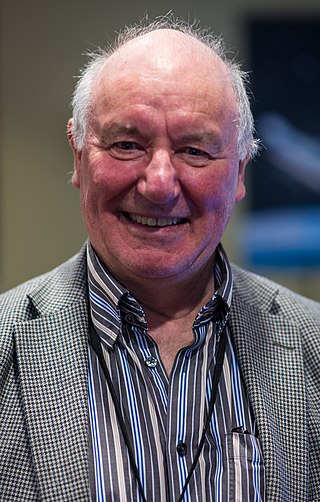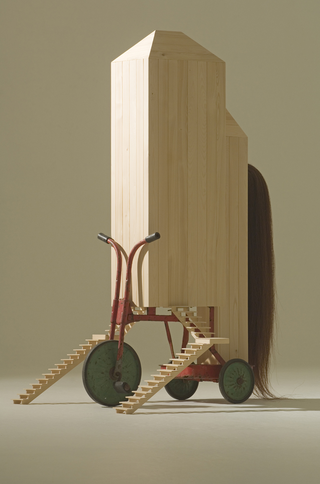Related Research Articles

The Cavendish Laboratory is the Department of Physics at the University of Cambridge, and is part of the School of Physical Sciences. The laboratory was opened in 1874 on the New Museums Site as a laboratory for experimental physics and is named after the British chemist and physicist Henry Cavendish. The laboratory has had a huge influence on research in the disciplines of physics and biology.

Antony Hewish was a British radio astronomer who won the Nobel Prize for Physics in 1974 for his role in the discovery of pulsars. He was also awarded the Eddington Medal of the Royal Astronomical Society in 1969.

Eleanor Margaret Burbidge, FRS (née Peachey; 12 August 1919 – 5 April 2020) was a British-American observational astronomer and astrophysicist. In the 1950s, she was one of the founders of stellar nucleosynthesis and was first author of the influential B2FH paper. During the 1960s and 1970s she worked on galaxy rotation curves and quasars, discovering the most distant astronomical object then known. In the 1980s and 1990s she helped develop and utilise the Faint Object Spectrograph on the Hubble Space Telescope. Burbidge was also well known for her work opposing discrimination against women in astronomy.

Malcolm Sim Longair is a British physicist. From 1991 to 2008 he was the Jacksonian Professor of Natural Philosophy in the Cavendish Laboratory at the University of Cambridge. Since 2016 he has been Editor-in-Chief of the Biographical Memoirs of Fellows of the Royal Society.

Dame Athene Margaret Donald is a British physicist. She is Professor Emerita of Experimental Physics at the University of Cambridge, and Master of Churchill College, Cambridge.

Germaine Greer is an Australian writer and public intellectual, regarded as one of the major voices of the second-wave feminism movement in the latter half of the 20th century.

Peter Brent Littlewood, FRS is a British physicist and Professor of Physics at the University of Chicago. He was the 12th Director of Argonne National Laboratory. He previously headed the Cavendish Laboratory as well as the Theory of Condensed Matter group and the Theoretical Physics Research department at Bell Laboratories. Littlewood serves as the founding chair of the board of trustees of the Faraday Institution.

Greer Honeywill is an Australian conceptual artist. Her work covers sculptural conventions, autobiography and critical thinking.

Frances Elizabeth Somerville Alexander was a British geologist, academic, and physicist, whose wartime work with radar and radio led to early developments in radio astronomy and whose post-war work on the geology of Singapore is considered a significant foundation to contemporary research. Alexander earned her PhD from Newnham College, Cambridge, and worked in Radio Direction Finding at Singapore Naval Base from 1938 to 1941. In January 1941, unable to return to Singapore from New Zealand, she became Head of Operations Research in New Zealand's Radio Development Lab, Wellington. In 1945, Alexander correctly interpreted that anomalous radar signals picked up on Norfolk Island were caused by the sun. This interpretation became pioneering work in the field of radio astronomy, making her one of the first women scientists to work in that field, albeit briefly.
Carolin Susan Crawford is a British communicator of science and astrophysicist. She is an emeritus member of the Institute of Astronomy, Cambridge and an emeritus fellow of Emmanuel College, Cambridge.

Elizabeth Rebecca Laird was a Canadian physicist who chaired the physics department at Mount Holyoke College for nearly four decades. She was the first woman accepted by Sir J. J. Thomson to conduct research at Cambridge University's Cavendish Laboratory. In her later life she studied electromagnetic radiation for military and medical applications.
Rachel Lindsey Webster, is an Australian astrophysicist who became the second female professor of physics in Australia. Her main focus areas are extragalactic astronomy and cosmology; she researches black holes and the first stars of the universe. Webster has a doctoral degree from Cambridge University and has held postdoctoral positions at the University of Toronto and University of Melbourne.
Frances Lowater (1871-1956) was a British-American physicist and astronomer.
Catherine Elizabeth "Cait" MacPhee is Professor of Biological Physics at the University of Edinburgh. After studying for her BSc in biochemistry and her PhD in medicine at the University of Melbourne she moved to the University of Oxford for postdoctoral research, where she was a research fellow at St Hilda's College, and subsequently held a Royal Society Dorothy Hodgkin Fellowship. From 2001-2005 she was a Royal Society University Fellow in the Cavendish Laboratory of the University of Cambridge and held a research fellowship at Girton College and then a fellowship at King's College. In 2006 she moved to the University of Edinburgh, where she became Professor of Biological Physics in 2011.

Hiranya Vajramani Peiris is a British astrophysicist at the University of Cambridge, where she holds the Professorship of Astrophysics (1909). She is best known for her work on the cosmic microwave background radiation, and interdisciplinary links between cosmology and high-energy physics. She was one of 27 scientists who received the Breakthrough Prize in Fundamental Physics in 2018 for their "detailed maps of the early universe."

Valerie Gibson, also known as Val Gibson, is a professor of Physics and Head of the High Energy Physics group at the University of Cambridge.

Nan Dieter-Conklin, also known as Nannielou Reier Hepburn Dieter Conklin, was an American radio astronomer.
Penelope Jane Brown is a neutron crystallographer and served as Senior Scientist at the Institut Laue–Langevin until 2012. In 2002 she was the first woman to win the Institute of Physics Michael Faraday Medal.
Ann Catherine Horton was a British physicist and academic who was the first woman to be appointed to the lecturing staff of the Cavendish Laboratory.
Lucy Marie Ziurys is an American astrochemist known for her work on high-resolution molecular spectroscopy. She is Regent's Professor of Chemistry & Biology and of Astronomy at the University of Arizona.
References
- ↑ "Rachael Padman". International Astronomical Union. 18 May 2011. Retrieved 6 March 2014.
- 1 2 3 4 "A gender for success". The Guardian. Guardian News and Media Limited. 14 August 2004. Retrieved 6 March 2014.
- 1 2 3 Garner, Clare (25 June 1997). "Fellows divided over don who breached last bastion". The Independent. Retrieved 7 March 2014.
- 1 2 Featherstone, Mike, ed. (2000). Body Modification (1st publ. ed.). London: Sage. pp. 219–220. ISBN 9780761967958.
- ↑ Reynolds, Flo (19 February 2013). "Arts history: Germaine Greer". Concrete. Retrieved 7 March 2014.
- ↑ Legge, Kate (26 December 2011). "Sex changes a school of thought". The Australian. Retrieved 6 March 2014.
- ↑ "Rachael Padman's story". ai.eecs.umich.edu. Retrieved 2 May 2019.
- ↑ Padman, R. (1982). "Short-wavelength observations of interstellar molecules". E-Thesis Online Service. The British Library Board. Retrieved 24 July 2023.
- ↑ Zagria (24 October 2008). "Rachael Padman (1954– ) physicist". A Gender Variance Who's Who.
- ↑ Mistiaen, Veronique (24 August 1997). "Can Cambridge's All-women College Survive The Change?". Chicago Tribune. Retrieved 7 March 2014.
- ↑ Baty, Phil (21 July 1997). "The essential guide to sexuality". TimesHigherEducation. TSL Education Ltd. Retrieved 7 March 2014.
- ↑ "When Germaine wants a job". The Guardian. 1997. Archived from the original on 1 December 1998. Retrieved 7 March 2014.
- ↑ "Writer Watch: Germaine Greer". Watchwords. Retrieved 6 March 2014.